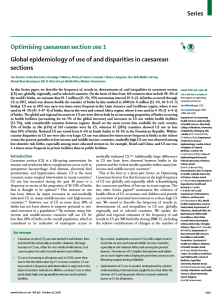
In this Series paper, we describe the frequency of, trends in, determinants of, and inequalities in caesarean section (CS) use, globally, regionally, and in selected countries. On the basis of data from 169 countries that include 98·4% of the world’s births, we estimate that 29·7 million (21·1%, 95% uncertainty interval 19·9–22·4) births occurred through CS in 2015, which was almost double the number of births by this method in 2000 (16·0 million [12·1%, 10·9–13·3] births). CS use in 2015 was up to ten times more frequent in the Latin America and Caribbean region, where it was used in 44·3% (41·3–47·4) of births, than in the west and central Africa region, where it was used in 4·1% (3·6–4·6) of births. The global and regional increases in CS use were driven both by an increasing proportion of births occurring in health facilities (accounting for 66·5% of the global increase) and increases in CS use within health facilities (33·5%), with considerable variation between regions. Based on the most recent data available for each country, 15% of births in 106 (63%) of 169 countries were by CS, whereas 47 (28%) countries showed CS use in less than 10% of births. National CS use varied from 0·6% in South Sudan to 58·1% in the Dominican Republic. Within-country disparities in CS use were also very large: CS use was almost five times more frequent in births in the richest versus the poorest quintiles in low-income and middle-income countries; markedly high CS use was observed among low obstetric risk births, especially among more educated women in, for example, Brazil and China; and CS use was 1·6 times more frequent in private facilities than in public facilities.
—
Caesarean section—the most common surgery in many countries around the world—is a procedure that can save women’s and babies’ lives when complications occur during pregnancy or birth. However, caesarean section use for non-medically indicated reasons is a cause for concern because the procedure is associated with considerable short-term and long-term effects and health-care costs. Caesarean section use has increased over the past 30 years in excess of the 10–15% of births considered optimal, and without significant maternal or perinatal benefits. A three-part Lancet Series on Optimising Caesarean Section Use reviews the global epidemiology and disparities in caesarean section use, as well as the health effects for women and children, and lays out evidence-based interventions and actions to reduce unnecessary caesarean sections.
Access the 2nd paper of the Lancet Series – Short-term and long-term effects of caesarean section on the health of women and children
Access the 3rd paper of the Lancet Series – Interventions to reduce unnecessary caesarean sections in healthy women and babies
Access the 1st Comments paper about the series – FIGO position paper: how to stop the caesarean section epidemic
Access the 2nd Comments paper about the series – Appropriate use of caesarean section globally requires a different approach
Access the 3rd Comments paper about the series – Strategic measures to reduce the caesarean section rate in Brazil
Access the Editorial paper about the series – Stemming the global caesarean section epidemic
Access the Profile paper related to the series – Ana Pilar Betrán: seeking the optimum use of caesarean section